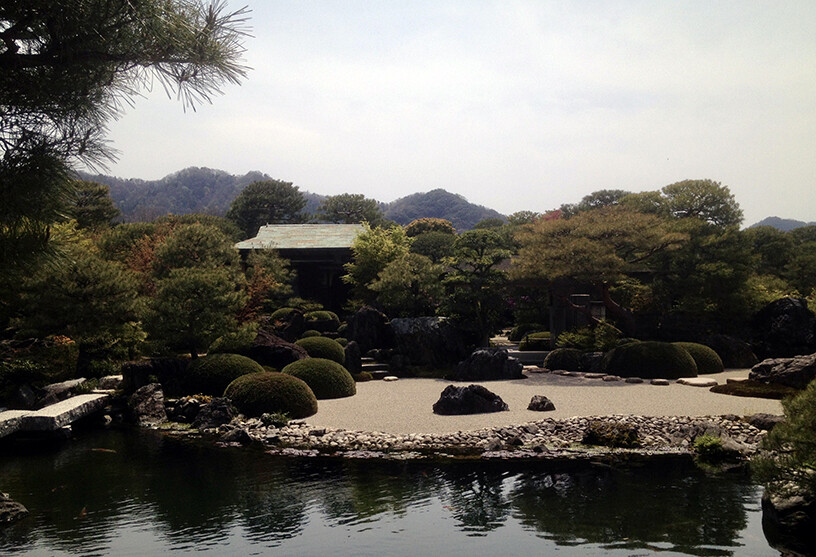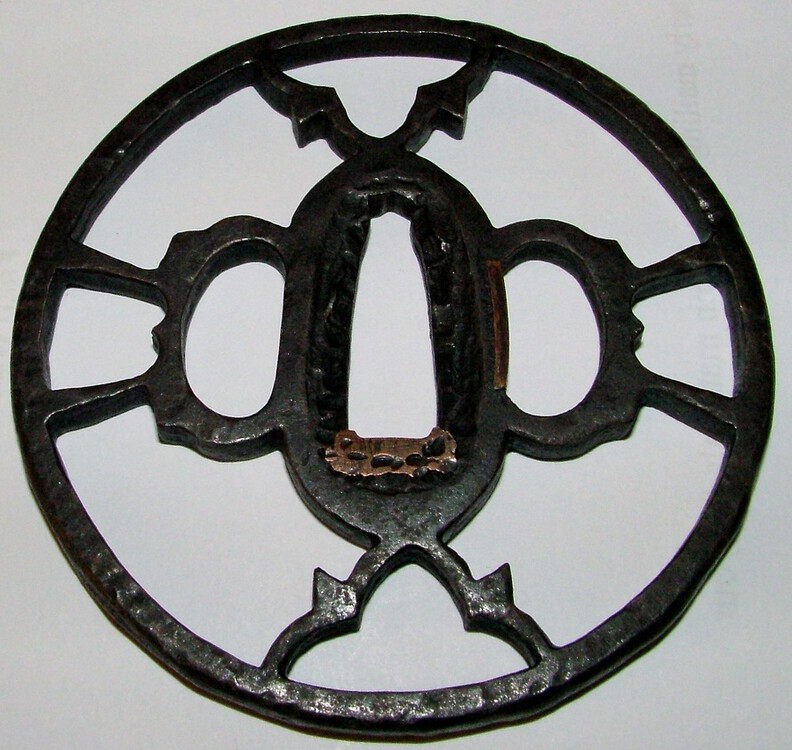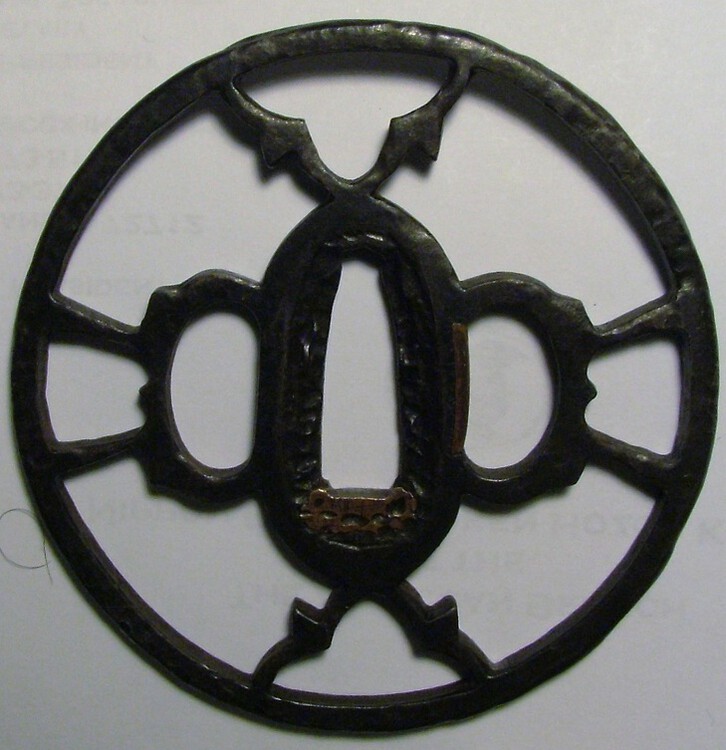-
Posts
2,886 -
Joined
-
Last visited
-
Days Won
3
Everything posted by Soshin
-
Hi David, Nice Owari Sukashi tsuba. Having some views of the rim would be great. I will do some searching and see if I can come up with something in terms of what the stylized Kanji characters are. Off the top of my head nothing comes to mind. Yours truly, David Stiles
-
Here is some translation of the tsuba signature. Yamashirokuniju 山城國住 (right of the nakago-ana) Umetada Mune? 埋忠宗? (left of the nakago-ana) The last Kanji I can't read. Having a detail photo of the tsuba directly in front would be helpful or just a scan. Camera flash is also making it hard to read. Please sign your name or some part of it on your posts. I hope you find the information helpful. Yours truly, David Stiles
-
Hi Everyone, I aggree with Guido's point I think there were wonderful works of art in all time periods. I like this tsuba regardless of age. It reminds me of a friends kagamisni tsuba that I dated to the Momoyama Period. I'm not completely condvenced with Sasano's early dating. Yours truly, David Stiles
-
Hi Marc, Really nice tsuba. Don't have any idea who made the tsuba as these type are not my strong point. Thanks for sharing. Yours truly, David Stiles
-
Hi David, The kozuka-hitsu ana looks original. Nornally a nonoriginal hitsu ana will cut throuht the design. Not sure of the age of the Tsuba other then I think it is Edo Period. Hope you find the information helpful. Yours truly, David Stiles
-
Hi David, The style of rim (dote mimi) and overall shape (maru-gata) reminds me of kachushi circa the Edo Period but frequently you would see some ko-sukashi or surface treatment and the difference in the thickness between the seppa-dai (middle) and mimi (rim) would be much greater often being a few milometers. I don't know anything about the Edo Period Satsuma school. Sorry about not being much help. Yours truly, David Stiles
-
Hi Pete, Thanks for taking the time to write up with such a detail explanation that I am sure will help improve my as well as others understanding of the topic. Comparing this tsuba to another signed Umetada tsuba with a similar style of openwork I do notice the similarities. Because this work is unsigned would the term Ko-Umetada (古埋忠) be applicable or is the work to late in the early Edo for that to be applicable? I am fully aware this is a nebulous term to being with. Yours truly, David Stiles
-
Hi Everyone, Quick note I updated this thickness measurements after remeasuring under direct light. The thickness of the seppa-dai is greater at 0.35 cm then the mimi which is only 0.25 cm. Still the thickness of 0.35 cm at the sappa-dai makes me think early Edo Period for age of this Tôshô (刀匠) tsuba. It was sold to me by a dealer in the USA as a early Edo Period Tôshô (刀匠) tsuba. Yours truly, David Stiles
-
Hi Curran, While my question is verbose there is a question mark in my post. Next time I will bold it and use a larger font size. :lol: To simplify my question would a Katchûshi (甲冑師) and Tôshô (刀匠) tsuba dated to the Azuchi-Momoyama Period be attributed to ko-Katchûshi (古甲冑師) or ko-Tôshô (古刀匠) officially on the shinsa paper by the NTHK and NBTHK? The reason I am asking is just for my own personal research and the correct association of a time period of production based upon an official attribution. Another way to state the question is if I see a Katchûshi (甲冑師) and Tôshô (刀匠) tsuba with the ko (古) prefix then I should date it to Muromachi Period assuming all other normal attribution points patina color, iron, workmenship, and style point to this early production period? Yours truly, David Stiles
-
Hi Everyone, Finished up my "Black Friday" shopping for myself on the NMB. :D Reading through my small collection of books a Tsuba terminology question developed in my mind that inclined me to start a thread the NMB Tosogu forum. The question started from some inconsistencies I have observed in the application of the prefix ko (古) meaning old in some English books on tosogu. The prefix of ko (古) is officially (i.e. NBTHK and NTHK kantei) used in the context of Katchûshi (甲冑師) and Tôshô (刀匠) tsuba for works of the Muromachi Period and earlier or just the pre-Edo Periods (i.e. Azuchi-Momoyama Period and before) works? Here is a photo of a early Edo Period Tôshô (刀匠) tsuba in my collection. The major kantei point why I think it is Tôshô (刀匠) and not Katchûshi (甲冑師) is because the thickness of the seppa-dai is greater at 0.35 cm then the mimi at 0.25 cm. This type of change in thickness where the seppa-dai is thicker is often seen in Tôshô (刀匠) and not Katchûshi (甲冑師) tsuba. Normally in Katchûshi (甲冑師) tsuba the rim significantly thicker then the center part of the tsuba. The complexity of the sukashi and surface treatment along with the thickness is another reason I think this is a Edo Period work. Thanks for taking the time to answer my question. Yours truly, David Stiles (Updated with new thickness measurements after remeasuring under direct light.)
-
Hi Marcello, The nanako-ji on the tsuba as well as the color of the patina of the shakudo is fairly poor. The poor color is likely due to the very low gold content. High quality shakudo with have a wonderful rich even dark blue-black color and have about 6% gold. Take a look at the Goto tsuba the guys from Tetsugendo.com posted on the tosogu board. This will give you a good reference of what great shakudo nanako-ji looks like on a tsuba. I would say that the tsuba was likely made in the Meiji Period and I would consider it Shiiremono (仕入物). On the bright side I don't think it is a Chinese fake. Yours truly, David Stiles
-
Hi Mike Y., Thanks for the photos of the wonderful Hikozo Higo tsuba. Having such wonderful examples to study are wonderful. I just going to set back, read, and learn. My current personal tastes are in line with the tsuba (T-143 Kyo Sukashi Tsuba) your currently have on your website that is on hold. :D Yours truly, David Stiles
-
Hi Everyone, How about we go from smilies to tsuba photos? Here are two photos I have of the tsuba before and after the process. From the photos not much can be detected. In hand the tsuba no longer has a whitish waxy film on its surface. Yours truly, David Stiles
-
Hi Everyone, Relax the weekend is almost here. Just a quick note. I was cleaning off wax from a tsuba I purchased from Japan where much of the Ibota wax had oxidized and created a white film on the tsuba. I cleaned off the old wax using the method discussed on Jim Gilbert's website. I rubbed the iron tsuba with a plain cotton rags and used old pieces of piano keys to remove all of the dirt and rust trapped by the old wax. I then heated the tsuba whiled holding it with cotton gloves and a cotton rag with a hairdryer to a warm temperature so warm to not allow the tsuba to be held with a bare hand. I then applied the Renaissance Wax and then worked the tsuba some more with another clean plain cotton rag. I will be posting before and after photos soon. I wouldn't recommend this type of process to anyone first starting out or working with a valuable tsuba, a kinko tsuba, or a tsuba with soft metal inlays. Yours truly, David Stiles
-
Hi Robert and Ford, Thank you Robert for asking the question and Ford for providing details. I have a can of Renaissance Wax just setting around. Yours truly, David Stiles
-
Hi Everyone, Thanks for posting a really nice tsuba! :D We all know that the shinto gods such as Raiden are all into the high end kinko works by the Goto school. :lol: Yours truly, David Stiles
-
Hi Marcello, Could you try to take some better quality photos of the tsuba that are in focus in the correct orientation? This would aid in identification. Overall color looks strange in the photos but it could just be the quality of the photos with poor lighting. Yours truly, David Stiles
-
Hi Ed, Nice write up about the significance of the mantra which is the design of the menuki. The mantra has been the focus of tosogu and koshirae since the Muromachi Period. I do remember seeing on the Yamabushi website a whole koshirae focus on Nichiren Buddhist designs a few years ago. It has long since been sold. This mantra is central to the practice of Nichiren Buddhism. One minor point which I can nitpick is that political party Sokugakkai is only associated with the Nichiren Shōshū (日蓮正宗) and not Nichiren Buddhism as a whole. I hope everyone finds the additional information helpful. Yours truly, David Stiles
-
Hi Everyone, I remember reading that some of the early Saotome tsuba also had mantra motifs of the Nichiren-shu on there surface. The Nidai Norisuke tsuba discussed above would be really great to take a look at. Now for the more on topic comments. Mounting this menuki set on a Gendaito sounds like a good idea. Overall they don't look like a bad reproduction and were made in modern Japan (i.e. Gendai). Yours truly, David Stiles
-
Hi Roy, Thanks for the nice comment about my website. I am glad you enjoyed it. Its still a work in progress. I just added another tsuba research write up on the Azuchi-Momoyama Period webpage. It's a nice small (i.e. for wakazashi) to the best of my knowledge Ko-Shoami tsuba. The owner before me was thinking it dated from the Muromachi Period. It is very thin at 1.5 mm at the rim and about 2.0 mm at the seppa-dai. Here is the direct link: http://mysite.verizon.net/vzeo23jk/id18.html. Yours truly, David Stiles
-
Hi Everyone, In asking my question I was just thinking that the tsuka and it's placement reminded be of my tsuka that I purposely placed the menuki in the reverse position as recommended by my school of batto which has its origin in Owari province during the early part of the Edo Period. I was just thinking that the original owner might have practiced the same or similar style of batto. Thank you John for providing additional information. Yours truly, David Stiles
-
Hi Roy, One quick but important question about the menuki mounted on tsuka. Are they in the palms of your hands when hold the tsuka with two hands? This is assuming you holding the tsuka with two hands as if your are doing iai or batto. Yours truly, David Stiles
-
Hi Fred, Thanks for posting so many wonderful photos of high end Nanban tsuba. :D I have a two nice ones but nothing like the ones you posted. Thank you very much for sharing. Yours truly, David Stiles
-
Hi Chris, Thanks for the clarification about the reading and meaning of the Kanji for the age of the tsuba. As well as the meaning of den (伝). Hi Curran, Don't have any Saotome tsuba of the same age to compare this tsuba to in terms of hardness. I was under the impression that the hot stamps were used by both groups. In the informaiton chart I posted above in the tread the hash # is listed as a Tenpo (Tempo) hot stamp design. More importantly I was right about the age of the tsuba. I am very happy with the shinsa result. :D Yours truly, David Stiles
-
Hi Curran, Thanks for sharing your very nice example. Chris Bowen helped me with the translation of the kantei results. The tsuba didn't paper to Saotome like I was thinking it would it papered to something different but related. It papered to "Den Tenpo" (伝天法) with the note in English "late Muromachi". The Kanji I think written are "Muromachi Suki" (室町末期) which literally means the end of the Muromachi Period. I think the den (伝) means in the tradition or legend of. The Saotome and Tenpo schools are closely related have some overlap in craftsmanship, designs, time period, and location. Yours truly, David Stiles






